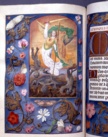
illumination
- Decoration with drawings,
usually in gold, silver, and rich colors,
especially in the initial letters of manuscripts,
particularly those done during the Middle
Ages. A manuscript, produced during the Middle Ages, in which
the pages are decorated this way. Often these manuscripts contain
small pictures known as
illuminations or miniatures.
One type of medieval illuminated manuscript was called a "book of hours" — a collection of texts for each liturgical hour of the day, along with other texts such as calendars, prayers, psalms and masses for holy days. The classic book of hours is Les Tres Riches Heures, one of the great art treasures of France, the greatest achievements of the art of manuscript illumination. It was painted by Paul, Hermann and Jean Limbourg (brothers, Flemish, each c. 1380-1416), 1412-1416, for the very wealthy Duke of Berry, a brother to a king and other dukes. The Limbourgs used a variety of colors obtained from minerals, plants or chemicals, mixed with either gum arabic or gum acacia to provide a binder for the paint. Among the more unusual colors they used were vert de flambe, a green obtained from crushed flowers mixed with massicot, and azur d'outreme, an ultramarine made from crushed Middle Eastern lapis-lazuli, used to paint the intense blues, and extremely expensive. The fine detail which was characteristic of the Limbourgs demanded extremely fine brushes and, almost certainly, magnifying lenses.
Examples of manuscript illuminations:
Francesco Pesellino (Francesco di Stefano) (Italian), Allegory of Rome, from De Secundo Bello Punico Poema by Silius Italicus, 1447-1457, gouache, gold leaf, pen and ink, watercolor on parchment 28.7 x 20.2 cm, Hermitage Museum, St. Petersburg, Russia.

Kach'atur, illustrator, and Yohannes, scribe
(priests in Khizan, Byzantine
Greater Armenia), The Gospels, 1455, tempera
and black ink on paper,
27.5 x 18 cm (10 7/8 x 7 1/8 inches), Walters Art Museum, Baltimore,
MD. This Christian text
was illuminated at a time when the Timurids — an Islamic sultanate — were in power in
this region. Although the iconography
is within Christian traditions,
much of the patterning
and costume
here reflect the taste of
the Timurids. The dramatic positions of the figures in the narrative,
the background details,
the serpentine, almost
abstract line
of the drapery folds,
the pattern of the wings, and Christ walking in pants with yellow
boots -- all are more closely allied to the taste of the Islamic
world in which the Armenians of Khizan lived.
France, Burgundy, Meeting of Mary and Elizabeth, from a Book of Hours, late 1460s-early 1470s, gouache on parchment, 21 x 15.5 cm, Hermitage Museum, St. Petersburg, Russia.

Master of the Old Prayerbook of Maximilian
I and Associates (Flemish, Ghent), The Hours of Queen Isabella of Spain,
c. 1497-1500, ink, tempera,
and gold on
vellum, 8 7/8 x 6 inches
(22.5 x 15.2 cm), Cleveland Museum of Art. See book
of hours.
Jean Fouquet (French, c. 1420- c. 1480), The Flight of Pompey After the Battle of Pharsalus, c. 1460-1476, Gothic, watercolor with gold gouache on vellum, 17 3/5 x 13 1/10 inches (44.5 x 33 cm), Louvre.
France, Rouen (?), [left] Magic Garden, [right] Jealousy Erects a Fortress, from Le Roman de la Rose by Guillaume de Lorris and Jean de Meung, early 16th century, gouache on parchment, 21.7 x 14.6 cm, Hermitage Museum, St. Petersburg, Russia.
Also see calligraphy, cathedrals, gargoyles, incunabulum, and typography.
https://inform.quest/_art